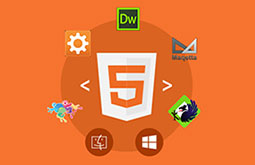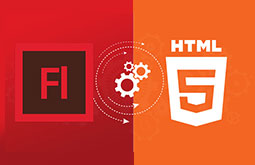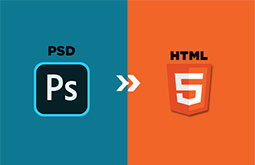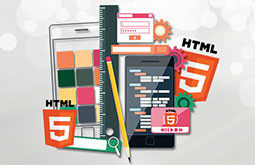Top Authoring Tools for Flash to HTML5 Conversion
Flash to HTML5 conversion has become more of a necessity. The conversion tools are also in the hype since these can make the process hassle-free.
Hypertext Markup Language 5 is one of the most preferred technologies for rendering videos online. Gone are the days when you needed the latest version of Adobe Flash to play the video. With HTML5, playing online videos has become more seamless and versatile. Besides, there are no compatibility or downloading issues involved.
The very conversation about Flash and HTML5 naturally brings us to the next pertinent question; how can one convert Flash files to HTML5? Let’s explain how to do it in detail in the next section.

How to Convert Flash Files to HTML5?
In the below points, we have briefly explained how Flash documents are converted into HTML5. However, we do suggest taking help from professionals if you don’t have prior experience for the same.
- Choose the desired files to be converted along with their source files.
- Carry out an extraction process to remove the content or media elements and keep it somewhere safe.
- Choose the desired authoring tool for the process of conversion.
- Select the GUI and needed interactivities you want to add in the new HTML5 files. You can also use templates for faster development.
- Create a prototype for the conversion strategy and get it approved by the stakeholder.
- Now, scale up the conversion process as per the chosen strategy.
- Carry out quality checking after conversion so it runs smoothly on multiple devices and browsers.
Also know the importance of Flash to HTML5 conversion.
Google Swiffy: An Efficient Convertor or Not?
There are several applications online to carry out the conversion of Flash to HTML5 content. Goggle Swiffy was one of the easily accessible and effective free converters that many designers and programmers used.
One of its main features which attracted many coders and designers is that it is exceptionally fast and could carry out conversions on the browser itself. However, this HTML5 conversion tool has become more and more redundant as there are several other applications published by various software developers.
Now, there are newer programs to carry out the same tasks better and more efficiently. All the programs are unique and understanding them is vital to choose the right one suitable for your needs.
Major Reasons for Using Authoring Tools
Whether you need to convert Flash-based eLearning Courses to HTML5or any other files, authoring tools offer an edge over Google Swiffy during the Flash to HTML5 migration process. This is contributing to their increasing popularity among e-course developers.
Besides, there are many reasons for using authoring tools to convert Flash to HTML5 content. Some of them are discussed below.
E-courses become compatible with different devices and browsers
Contemporary learners using e-courses don’t want to remain bound to a particular device or browser. They seek versatility in accessing the courses. This is made possible through e-learning courses converted with authoring tools. A learner can choose a preferred device and browse the course at his/ her convenience.
Flash courses suffered from the limitation that they could not be played on modern devices such as Android smartphones, iPhones, iPads, Android tabs, advanced laptops etc. Once the e-content has been converted from Flash to HTML5 with the help of authoring tools, it becomes responsive. Resultantly, the content in HTML5 format can be accessed from any mobile device or browser of choice.
Courses can be translated easily into different languages
When a Flash based course is translated manually or with Swiffy, one needs to retrieve suitable content, place the same in standardized template, and then go about replacing the content with translated version within the course. This consumes significant amount of time.
However, when authoring tools are used for conversion of Flash based eLearning course into HTML5, you can avail of the in-built support for HTML5 export. This simplifies the process of translation. By leveraging the functionalities of tools, precisely translated eLearning content can be made available to learners so that they can browse the courses in their preferred languages.
The authoring tools offer multi-language option for publishing content. By exercising this option, the entire course content can be exported to RTF format for translation with a single click. The RTF format is globally preferred by translation vendors. After completion of translation, the translated content can be incorporated in the eLearning module for publishing in HTML5 format. You can convert elearning courses into multiple languages easily and quickly with authoring tools.
In the eLearning market, many authoring tools with cutting-edge conversion features are available. You can expeditiously transform Flash based content to HTML5 format. With the help of authoring tools, obsolete eLearning content can be redesigned or translated to multiple languages so that the needs of contemporary learners are catered to.
Top Best Tools to Convert Flash-based Content to HTML5
Let us discuss about some of the best flash to html5 conversion tools in the industry. Some prominent ones are underlying.
-
Articulate Storyline

Articulate Storyline The preeminent in the list, Articulate Storyline is undeniably the best in the industry when it comes to carrying out Flash to HTML5 conversion quite effortlessly and efficiently. Boasting of all the features and tools that anyone in the publishing business would expect in a Flash to HTML5 converter, Articulate Storyline champions when it comes to helping publishers to convert the content from any platform where it is hosted. It is capable of achieving Flash to Hypertext Markup Language conversions on platforms such as desktops, laptop, iPad and even from a multitude of hand-held or mobile devices. It also provides the user with a wide range of default templates and interactive capabilities that can be used as they are or customized for better results; customized solutions are always appreciated.
-
Adobe Captivate

Adobe Captivate Though Adobe Captivate was published as a software program to help develop training simulations, it has been on the rise into becoming one of the best, most reliable and effective tools to carry out Flash to HTML5 conversion. This tool is endowed with numerous templates and interactivities that you can seamlessly incorporate into the final output. Adobe Captivate also adorns itself with quite a few features such as support for Tin Can API and a widget for Twitter, along with the capability of embedding YouTube videos. These value-adding services make Adobe Captivate Flash one of the best conversion tools, especially for converting eLearning courses based on adobe flash into html5.
-
Lectora Inspire Conversion Suite

Lectora Inspire Conversion Suite Hailed and lauded as the fastest conversion tool that one can get his/her hands on in the market now, Lectora lives impeccably up to all its promises and expectations of the users, as well which is the reason for its wide acceptance. Further, quite surprisingly, Lectora is also capable of converting text-dominated courses to simple and effective HTML5 formats which can render quickly even on the small screens of various hand-held devices. The tool also boasts of unique features such as in-built click-on-tabs, index or table of content along with many others. Capable enough of converting the eLearning courses and content to SCORM and AICC, apart from HTML5, this tool helps your users to access the content on a wide variety of platforms including computers, iPads or any other hand-held devices. There are a lot of tips for converting flash to html5 to be considered while using this tool.
-
iSpring Conversion Tools

iSpring Conversion Tools This is one of the most favorite tools among flash animation to html5 companies. Being a little different from all other tools that we have discussed so far, iSpring provides not the same league of services. Unlike other tools in this list, iSpring can help convert PowerPoint presentations to HTML5 effortlessly supporting all types of eLearning courses and modules. With the help of this tool, it is pretty easy to create mobile-ready PowerPoint presentations without having to break a lot of sweat. Capable of preserving all the animations and interactivity that you might have incorporated to the presentation, iSpring can endow the user with similar results in the HTML5 version, too.
-
Adapt Learning

Adapt Learning This is extensively used eLearning authoring tool. It is an open-source tool that allows the users to access e-learning content simultaneously from various devices. It is run on JavaScript and HTML5 code, and the users can enjoy the compatibility for multiple device, multi-screen, multi-browser and multi-platform during the eLearning courses. Evidently, creating a single course supports multiple screens, browser platforms and versions. The eLearning courses developed using this tool do not need a distinct version to follow the Disability Discrimination Act (DDA) guidelines.
-
Elucidat

Elucidat If you are looking for rapid authoring tools for eLearning, you can use Elucidat. It hastens the eLearning process and enables the users to develop highly engaging eLearning courses based on HTML-5. These are of high quality and you can access them from any device. You will not require training priory in advance when you use this tool. It is user-friendly and beginners can easily use it. The learners are able to create their own interactions, using the ‘look and feel’ specialty of the tool in the virtual course
-
isEasy

isEasy isEasy is a cloud-based authoring tool that assures 100% safety and security of the user’s work. It supports both Flash and HTML5 based content while enabling users to carry out the editing process in real-time. It makes the content more dynamic and productive so that it can be effectively used for training programs. The platform also has a simple interface that allows users to easily use it even if they are unaware of the technical know-how.
-
Zenler Studio

Zenler Studio This authoring tool enables the users to develop simple and effective eLearning courses. It is a supplementary to PowerPoint and has two versions. This is a native application and you can also use ‘web-based Zenler’, which allows users to publish the eLearning materials, manage them and keep a track on the progress of the learners.
-
Raptivity

Raptivity This is one of the authoring tools for eLearning for beginners. This tool can be used without any knowledge in programing. It enables the users to customize the courses in quick time and develop unique interfaces. The users can publish in both of Flash as well as HTML5 formats, using the tool. It provides access to as many as 200 elements interactively, including virtual GUIs and games.
-
Agylia Learning Management System(LMS)

Agylia Learning Management System You can use this tool to create huge volumes of online courses based on HTML. It can be used in developing interactive eLearning courses, with various multimedia components of audio, video, graphics, enriched text content and assessments. HTML 5 output enables the users to access the course on multiple devices. You can also look out for an adobe flash to html5 conversion tool to suit your purpose.
-
dominKnow | One

dominKnow | One Has become popular as a useful authoring tool in eLearning segment. The dominKnow platform has released a number of authoring tools which have been subjected to improvisation. This is evident from dominKnow | One release which blends the power of dominKnow Claro with the responsiveness of dominKnow Flow. The authoring tool also has inbuilt support to facilitate simulations of software.
This tool is cloud based. Different eLearning course developers can collaborate for collectively working on various projects. The turnaround time thus becomes lower. Courses in Flash can be converted to HTML5 really fast. The courses can be reviewed by different reviewers from multiple locations.
Advantages: The authoring tool permits the usage of custom scripts, triggers and variables which allows for customization. Recreation and rebuilding of the interactions which were Flash based can be done easily. As all the resources are centrally shared on the cloud, reuse of learning components becomes easier. The tool is being updated at regular intervals. Keeping this in perspective, it would be wise to expect new update of dominKnow with more advanced features sooner.
-
SmartBuilder

SmartBuilder The SmartBuilder tool can easily allow creation of eLearning courses which are complex in nature. Quizzes, textual content, interactivities, and multimedia elements can be integrated with ease. eLearning developers who have already worked with content authoring tools would find it really productive to use. The tool does not support editing videos and recording screens. For Flash powered e-courses, you need to have all the source files as the ‘record’ mode would not work while converting Flash to HTML5.
Advantages: You can avail of a number of interactions which can be readily used. The templates and functional aspects are flexible to use and apply.
-
Gomo

Gomo This authoring tool prides itself of an intuitive interface. eLearning developers can work and collaborate without experiencing any location based constraint. This is because the tool is hosted over the cloud. The tool may not be suitable for your needs if you want it to be ultra-flexible in designing.
Advantages: When you need more agility in Flash to HTML5 conversion, you can use the quick start wizards and inbuilt templates to become more productive. Another important feature is the inclusion of beginner guides which offers step by step direction for developing eLearning courses. The tool is based in cloud. It supports eLearning course development in multiple languages.
-
Easygenerator

Easygenerator This easy to use authoring tool can facilitate development of eLearning courses in-house. However, the tool lacks the number of interactivities which are offered by other authoring tools like the dominKnow and Storyline.
Advantages: The tool is easy to use. It is responsive in nature which facilitates development of courses for mobile. You can develop different formats for questionnaires. Quizzes can be customized.
-
Composica

Composica Composica is a great authoring tool for facilitating collaboration of team members on any project. The tool does not support redressing of the developers’ queries and as such it has not been very successful for converting Flash courses to HTML5
Advantages: The tool has inbuilt support for group development function. Different developers can be part of the same project. However, the same slide cannot be worked upon by all at one point of time
These eLearning authoring tools are most extensively used for HTML5 output. You can go for the free deals that the tools offer. Depending on your expenses, you need to choose the right open-source tool.
You can also try out these tools to know the pros and cons and see if they cater to your requirements. However, it is necessary to gain expertise in using these tools to get the desired output. You can check out Converting flash to html5- Merits in e-learning for further details.
Now that you are aware of the Hypertext Markup Language 5 and the conversion tools, you can employ it to the best of your advantage. However, if you are not experienced and the files you want to convert are important, then don’t take the risk to do it yourself.
In that case, the best solution is to convert your SWF website to HTML5 through a professional flash to html5 service provider having years of experience, top-notch solutions quality, and adequate technological infrastructure.



















